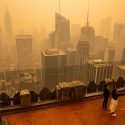
“How’s the smoke in Ottawa?” I texted my friend early Wednesday morning. Toronto smelled like yesterday’s campfire and the sky had a golden glow to it, but the haze had thinned.
“It’s so bad,” came the response. “Climate anxiety is at an all-time high. It feels apocalyptic.”
Ottawa’s Air Quality Health Index, a measure of the health risk floating by on the breeze at a given hour, was off the charts at 6 a.m., measuring 28 out of 10. Local hospitals were already seeing a surge in patients.
It’s hard to ignore climate change when it’s scratching the back of your throat and making it hard to breathe.
In Toronto, the arrival of summer isn’t usually marked by hazy mornings, air quality warnings and cancelled outdoor children’s programs. The AQHI has been around for nearly a decade, but many of us have hardly used it. In the years to come, smoky days may become normal as human-caused climate change worsens wildfires across the country and makes them harder to control.
Quebec wildfires
The smoke spreading through eastern Ontario was coming from Quebec, where 149 active fires were burning as of Wednesday afternoon, mostly out of control. Federal officials counted 414 blazes across the country, with 239 raging uncontrollably.
In Canada, the wildfire season typically spans April to October and peaks in July. On average, more than 8,000 fires occur annually, burning about 2.1 million hectares across the country. This year, more than 3.8 million hectares of forest have already been torched.
… continue reading at the Toronto Star.

Leave a Reply